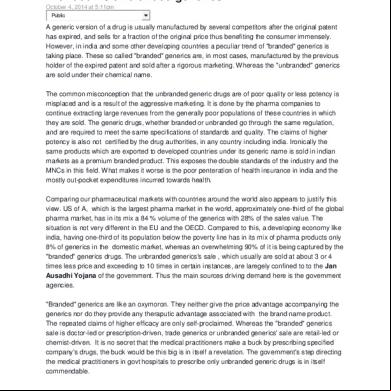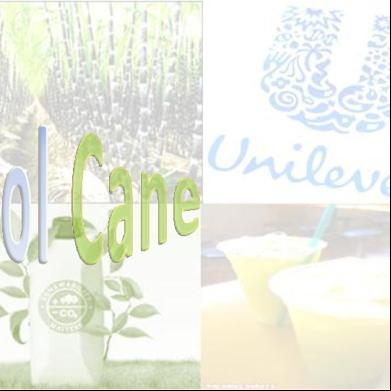Branded Vs Unbranded Generics 323s4w
This document was ed by and they confirmed that they have the permission to share it. If you are author or own the copyright of this book, please report to us by using this report form. Report 3b7i
Overview 3e4r5l
& View Branded Vs Unbranded Generics as PDF for free.
More details w3441
- Words: 665
- Pages: 2
Branded Vs unbranded generics October 4, 2014 at 5:11pm Public
A generic version of a drug is usually manufactured by several competitors after the original patent has expired, and sells for a fraction of the original price thus benefiting the consumer immensely. However, in india and some other developing countries a peculiar trend of "branded" generics is taking place. These so called "branded" generics are, in most cases, manufactured by the previous holder of the expired patent and sold after a rigorous marketing. Whereas the "unbranded" generics are sold under their chemical name. The common misconception that the unbranded generic drugs are of poor quality or less potency is misplaced and is a result of the aggressive marketing. It is done by the pharma companies to continue extracting large revenues from the generally poor populations of these countries in which they are sold. The generic drugs, whether branded or unbranded go through the same regulation, and are required to meet the same specifications of standards and quality. The claims of higher potency is also not certified by the drug authorities, in any country including india. Ironically the same products which are exported to developed countries under its generic name is sold in indian markets as a branded product. This exposes the double standards of the industry and the MNCs in this field. What makes it worse is the poor penteration of health insurance in india and the mostly out-pocket expenditures incurred towards health. Comparing our pharmaceutical markets with countries around the world also appears to justify this view. US of A, which is the largest pharma market in the world, approximately one-third of the global pharma market, has in its mix a 84 % volume of the generics with 28% of the sales value. The situation is not very different in the EU and the OECD. Compared to this, a developing economy like india, having one-third of its population below the poverty line has in its mix of pharma products only 8% of generics in the domestic market, whereas an overwhelming 90% of it is being captured by the "branded" generics drugs. The unbranded generics's sale , which usually are sold at about 3 or 4 times less price and exceeding to 10 times in certain instances, are laregely confined to to the Jan Ausadhi Yojana of the government. Thus the main sources driving demand here is the government agencies. "Branded" generics are like an oxymoron. They neither give the price advantage accompanying the generics nor do they provide any theraputic advantage associated with the brand name product. The repeated claims of higher efficacy are only self-proclaimed. Whereas the "branded" generics sale is doctor-led or prescription-driven, trade generics or unbranded generics' sale are retail-led or chemist-driven. It is no secret that the medical practitioners make a buck by prescribing specified company's drugs, the buck would be this big is in itself a revelation. The government's step directing the medical practitioners in govt hospitals to prescribe only unbranded generic drugs is in itself commendable.
Different committies and task forces appointed by the government, from the Hathi committee in 1975 to the Pranob sen Task Force & the recent V.M. Katoch task frocehave all recommended that the single-ingredient drugs must only be sold under a generic name. This may require the drug controllers to grant marketing approvals to generic names and not brand names. Which in turn might require an amendment of the Trademark act.
The measures needed to straighten this skewed business practices may consist of :
1. a ive legislation and regulations to make prescription in generic names mandatory., deviations to be permitted only when associated with full justification. 2. mandatory debranding of generic drugs in a phased manner. 3. Quality assurance capacity and the procedures to demonstrate bioequivalence should be enhanced 4. widespread info dissemination on drug prices. 5. incentives to drug industry should be used to promote genric drugs. Only then our vision of affordable healthcare to all would be\come a reality.
A generic version of a drug is usually manufactured by several competitors after the original patent has expired, and sells for a fraction of the original price thus benefiting the consumer immensely. However, in india and some other developing countries a peculiar trend of "branded" generics is taking place. These so called "branded" generics are, in most cases, manufactured by the previous holder of the expired patent and sold after a rigorous marketing. Whereas the "unbranded" generics are sold under their chemical name. The common misconception that the unbranded generic drugs are of poor quality or less potency is misplaced and is a result of the aggressive marketing. It is done by the pharma companies to continue extracting large revenues from the generally poor populations of these countries in which they are sold. The generic drugs, whether branded or unbranded go through the same regulation, and are required to meet the same specifications of standards and quality. The claims of higher potency is also not certified by the drug authorities, in any country including india. Ironically the same products which are exported to developed countries under its generic name is sold in indian markets as a branded product. This exposes the double standards of the industry and the MNCs in this field. What makes it worse is the poor penteration of health insurance in india and the mostly out-pocket expenditures incurred towards health. Comparing our pharmaceutical markets with countries around the world also appears to justify this view. US of A, which is the largest pharma market in the world, approximately one-third of the global pharma market, has in its mix a 84 % volume of the generics with 28% of the sales value. The situation is not very different in the EU and the OECD. Compared to this, a developing economy like india, having one-third of its population below the poverty line has in its mix of pharma products only 8% of generics in the domestic market, whereas an overwhelming 90% of it is being captured by the "branded" generics drugs. The unbranded generics's sale , which usually are sold at about 3 or 4 times less price and exceeding to 10 times in certain instances, are laregely confined to to the Jan Ausadhi Yojana of the government. Thus the main sources driving demand here is the government agencies. "Branded" generics are like an oxymoron. They neither give the price advantage accompanying the generics nor do they provide any theraputic advantage associated with the brand name product. The repeated claims of higher efficacy are only self-proclaimed. Whereas the "branded" generics sale is doctor-led or prescription-driven, trade generics or unbranded generics' sale are retail-led or chemist-driven. It is no secret that the medical practitioners make a buck by prescribing specified company's drugs, the buck would be this big is in itself a revelation. The government's step directing the medical practitioners in govt hospitals to prescribe only unbranded generic drugs is in itself commendable.
Different committies and task forces appointed by the government, from the Hathi committee in 1975 to the Pranob sen Task Force & the recent V.M. Katoch task frocehave all recommended that the single-ingredient drugs must only be sold under a generic name. This may require the drug controllers to grant marketing approvals to generic names and not brand names. Which in turn might require an amendment of the Trademark act.
The measures needed to straighten this skewed business practices may consist of :
1. a ive legislation and regulations to make prescription in generic names mandatory., deviations to be permitted only when associated with full justification. 2. mandatory debranding of generic drugs in a phased manner. 3. Quality assurance capacity and the procedures to demonstrate bioequivalence should be enhanced 4. widespread info dissemination on drug prices. 5. incentives to drug industry should be used to promote genric drugs. Only then our vision of affordable healthcare to all would be\come a reality.





